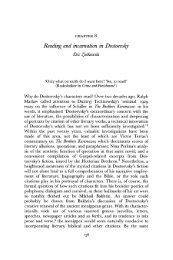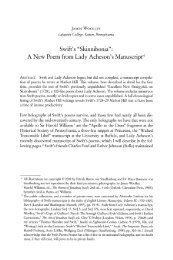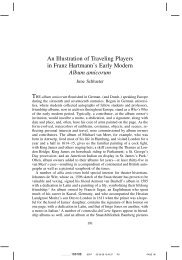courses of instruction - Lafayette College
courses of instruction - Lafayette College
courses of instruction - Lafayette College
Create successful ePaper yourself
Turn your PDF publications into a flip-book with our unique Google optimized e-Paper software.
creativity, and communications including<br />
the fundamentals <strong>of</strong> computer-aided<br />
graphics. Using the theme <strong>of</strong> the design<br />
project, engineering topics are taught as<br />
needed. Students participate as team<br />
members and, at times, independently to<br />
solve problems which are part <strong>of</strong> the<br />
theme. Lectures/recitation/laboratory.<br />
Offered in fall semester. Staff<br />
215. (History 215) History <strong>of</strong> Technology.<br />
A study <strong>of</strong> technology from the irrigation<br />
cities <strong>of</strong> the ancient world through militari<br />
ly financed systems <strong>of</strong> the late 20th century.<br />
The course stresses the important role<br />
played by cultural influences in determin<br />
ing the nature, extent, and direction <strong>of</strong> tech<br />
nological development. Attention focuses<br />
on processes <strong>of</strong> invention and innovation<br />
and their impact on the growth <strong>of</strong> modern<br />
Western civilization. Prerequisite: junior<br />
or senior standing. Lecture/discussion.<br />
Offered in fall semester. Mr. Jackson<br />
225. Engineering Pr<strong>of</strong>essionalism and<br />
Ethics. An introduction to the role <strong>of</strong> the<br />
engineer in society, time value <strong>of</strong> money<br />
concepts and engineering economic deci<br />
sions, engineering ethics, safety and risk<br />
assessment, the pr<strong>of</strong>essional responsibili<br />
ties <strong>of</strong> engineers, and the legal aspects <strong>of</strong><br />
engineering. Lecture/discussion. Prereq<br />
uisite: Sophomore standing. Offered in<br />
spring semester. Staff<br />
226. Statics. Introduction to the analytical<br />
methods <strong>of</strong> engineering and engineering<br />
computation through the analysis <strong>of</strong> equi<br />
librium force systems. Computational<br />
s<strong>of</strong>tware is utilized. Topics include vector<br />
algebra, resultants <strong>of</strong> force systems; free<br />
body analysis, friction; first and second<br />
moments <strong>of</strong> area, shear and bending<br />
moment diagrams. Prerequisites:<br />
Mathematics 162; Physics 131. Offered<br />
in fall semester. Staff<br />
230. Strength <strong>of</strong> Materials. Stress and<br />
strain relationships in tension, compres<br />
sion, shear, and combined loading. Materi<br />
al properties. Theory and design <strong>of</strong> pres<br />
sure vessels, beams and columns. Analysis<br />
<strong>of</strong> torsion, bending and transverse loading.<br />
ENGINEERING<br />
Deflections. Prerequisite: ES 226. Corequi-<br />
site: Mathematics 264. Lecture. Offered in<br />
spring semester. Staff<br />
231. Nature <strong>of</strong> Engineering Materials.<br />
Nature and properties <strong>of</strong> metals, ceramics,<br />
polymers, and other materials in engineer<br />
ing applications. Interpretation <strong>of</strong> the me<br />
chanical, physical, and chemical proper<br />
ties from the viewpoint <strong>of</strong> scientific disci<br />
plines. Prerequisites: Chemistry 121, or<br />
permission <strong>of</strong> instructor; Mathematics 161.<br />
Offered as an elective for physics and<br />
chemistry majors. Lectures/recitation/lab<br />
oratory. Offered in fall and spring semes<br />
ters. Staff<br />
385. Environmental Engineering. An<br />
introductory course dealing with human's<br />
impact on the environment. Conservation<br />
<strong>of</strong> natural resources is covered with em<br />
phasis on engineering approaches. Global,<br />
national, and local concerns including the<br />
origins <strong>of</strong> pollution, and the design, selec<br />
tion, and application <strong>of</strong> control methods<br />
are discussed. Lecture. Prerequisites: a<br />
first course in college chemistry, or high<br />
school chemistry, and permission <strong>of</strong><br />
instructor. Offered as needed. Staff<br />
CHEMICAL ENGINEERING<br />
Associate Pr<strong>of</strong>essor ].R. Martin, Head;<br />
Associate Pr<strong>of</strong>essors Piergiovanni, Schaffer,<br />
Tavakoli, and Uz; Assistant Pr<strong>of</strong>essor Moor<br />
Chemical engineers are people who solve<br />
problems. They design new kinds <strong>of</strong><br />
metals and plastics, devise new ways to<br />
manufacture fuels, and market chemicals.<br />
Sometimes, working with physicians,<br />
they help to create artificial organs.<br />
Traditionally, they take the work <strong>of</strong><br />
chemists and turn it into large-scale<br />
production. They deal with everything<br />
from high-level mathematics to piping in<br />
a chemical plant. Their work requires a<br />
strong mathematical and scientific back<br />
ground and the ability to think creatively.<br />
The curriculum emphasizes general<br />
pr<strong>of</strong>iciency in science and mathematics in<br />
the first two years followed by pr<strong>of</strong>ession<br />
ally oriented work in the final two. Majors<br />
87











